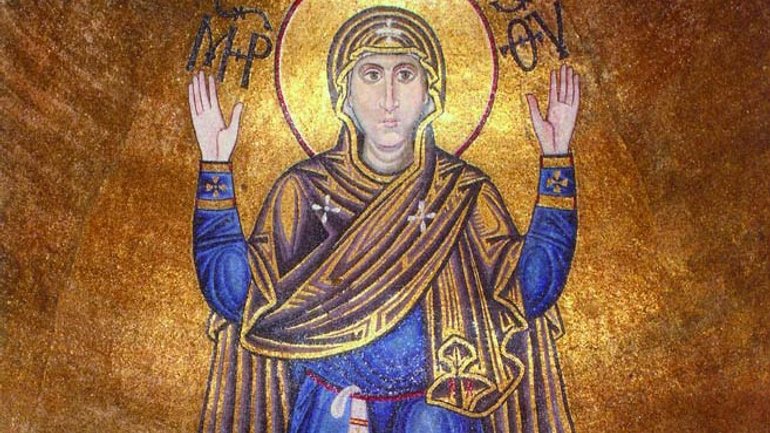
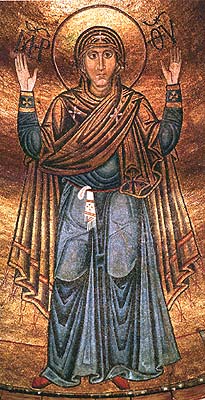 When
Prince Yaroslav the Wise built Sophia Cathedral in Kyiv and the Church
of the Annunciation above the Golden Gates, he entrusted all people of
Rus to the care of the Mother of God. Since then, as written sources
say, many princes defeated their enemies under the motherly patronage of
the Ever-Virgin Mary.
When
Prince Yaroslav the Wise built Sophia Cathedral in Kyiv and the Church
of the Annunciation above the Golden Gates, he entrusted all people of
Rus to the care of the Mother of God. Since then, as written sources
say, many princes defeated their enemies under the motherly patronage of
the Ever-Virgin Mary.
“Pokrova” (the feast of the Protection of the Mother of God or the Intercession of the Virgin Mary) was especially revered during the Cossack period. Zaporizhian Cossacks had a Church of the Intercession in Sich, where they would begin their campaigns against the enemies. In 1947, the Ukrainian Insurgent Army declared the day of the Protection of the Mother of God their official holiday.
The history of this feast goes back to the Byzantine Empire. The story from the Life of Andrew the Fool-for-Christ about his vision in the Blachernae church in Constantinople became the basis for the feast and the iconography of its image. According to the story, Andrew saw the Mother of God surrounded by angels and saints. The Most-Pure was holding the Omophorion over the people, protecting them from the Arabs invading the city. According to some versions, Andrew the Fool was of Scythian-Slavic origin. He ended up in Tsargrad as a slave, where he accepted the Christian faith. Taking the words of St. Apostle Paul to heart, “We are fools for Christ, but you are wise in Christ” (Cor. 1, 4-10), he became the Fool-for-Christ. These events are dated differently according to various versions. Most likely, they took place during the reign of Emperor Leo IV (886-911).
Andrew would be depicted half-naked, pointing his disciple Epiphanius towards the Mother of God. In the center, St. Romanos the Melodist, the creator of hymns honoring the Mother of God, is traditionally depicted on the pulpit; next to him are the patriarch of Constantinople, the emperor, and other spiritual and secular figures. The main iconographic differences lie in the depiction of the Virgin Herself. She is shown either in the Oranta posture and two angels holding a veil over Her or with the Omophorion held by the Virgin Mary herself. This theme gained considerable popularity in the Ukrainian art of the Baroque period, especially in Eastern Ukrainian painting, where it takes on the features of the Western European tradition, the so-called version of the “Mother of Mercy”, also known in Ukraine as the “Cossack Pokrova”. The Mother of God was depicted with Her standing at full height and covering people of different ages, status, and gender with Her cloak. Among them, the weak, sick, and crippled were oft depicted lying in the foreground. In such icons, one can often see portrait similarities with political and spiritual figures of that time. Eastern Ukrainian icons of this kind often depict Cossack senior officers. Historical figures are given portrait features.
The Protection of the Mother of God belongs to the original phenomena in Ukrainian icon painting. It is unique in being represented by various iconographic and compositional options. The oldest images of this theme date back to the period of Kyivan Rus, though relatively few works represented them until the beginning of the 17th century.
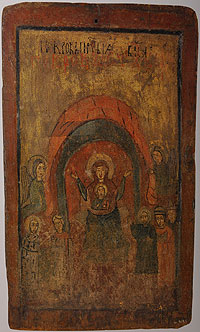 Obviously,
the Protection of the Mother of God iconography originated from Kyiv,
where churches were built to honor this feast in the 12th century.
Obviously,
the Protection of the Mother of God iconography originated from Kyiv,
where churches were built to honor this feast in the 12th century.
The plot of “Pokrova” is based on the intercession prayer of the Mother of God before Christ, reflecting the cult of the Mother of God-the Protector. The oldest known relic comes from Halychyna and dates back to the beginning of the 13th century (kept in the collection of the State Art Museum of Ukraine). It is a typical Ukrainian icon based on the theme of the pre-Mongol period, as it reflects the early stage of the formation of this plot. The icon represents a unique version of the Intercession, where the Mother of God is seated on a throne in the Oranta position, with the Baby Christ on Her breast and two angels holding a veil over Her. In this way, the idea of Intercession combines with the concept of the Divine Incarnation.
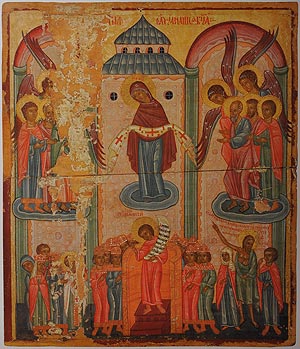 The
next relic dates back to the end of the 15th-the beginning of the 16th
century. It is the icon from the Church of the Intercession of the
Virgin Mary in Richvald (now the village of Ovchary, the territory of
Poland, belongs to the collection of the National Museum in Lviv named
after Andrei Sheptytskyi, hereinafter ‒ NML). The plot showing a rather
crowded environment is depicted in two tiers. In the upper center,
against the central part of the church, the Mother of God is holding the
Omophorion Veil about waist level. The Mother of God is standing on a
cloud with Her head bowed to the left. On both sides, also on the
clouds, there are angels in arched frames with raised brown wings and
saints in postures for adoration. Below, St. Romanos the Melodist stands
on the pulpit, wearing a red sticharion and holding an unfolded scroll
in his left hand; with a blessing gesture, he addresses the spiritual
figures standing in a dense group around the pulpit. To his left is a
bishop, the king and the queen; behind them stand a blue-robed woman and
a young man; on the right, Andrew the Fool points Epiphanius towards
the vision.
The
next relic dates back to the end of the 15th-the beginning of the 16th
century. It is the icon from the Church of the Intercession of the
Virgin Mary in Richvald (now the village of Ovchary, the territory of
Poland, belongs to the collection of the National Museum in Lviv named
after Andrei Sheptytskyi, hereinafter ‒ NML). The plot showing a rather
crowded environment is depicted in two tiers. In the upper center,
against the central part of the church, the Mother of God is holding the
Omophorion Veil about waist level. The Mother of God is standing on a
cloud with Her head bowed to the left. On both sides, also on the
clouds, there are angels in arched frames with raised brown wings and
saints in postures for adoration. Below, St. Romanos the Melodist stands
on the pulpit, wearing a red sticharion and holding an unfolded scroll
in his left hand; with a blessing gesture, he addresses the spiritual
figures standing in a dense group around the pulpit. To his left is a
bishop, the king and the queen; behind them stand a blue-robed woman and
a young man; on the right, Andrew the Fool points Epiphanius towards
the vision.
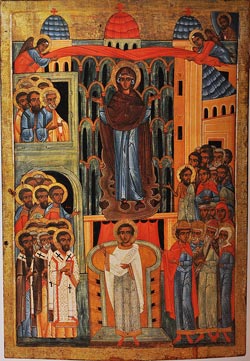 The
icon from the Holy Trinity Church in Richytsia, in the Volyn region
(the collection of the Rivne Museum of Local History), dates back to
approximately the same time as the icon from Richvald. It represents
another excellent version of the iconography of the patron saint theme.
The Virgin is depicted in the Oranta posture, similar to the mosaic
image in the central apse of Sophia of Kyiv. In the upper right corner
of the icon, there is a bust of Christ. The Mother of God is standing
against the three-domed Church, as if in a cross-section with a fairly
realistic interpretation of individual architectural parts, which
obviously reproduce the elements of a specific building. In particular,
it is interesting that the curtain closes the portal behind Romanos the
Melodist. This indicates that at that time, it was not yet acceptable to
close the central entrance to the sanctuary with the Royal Doors. This
practice can be observed in the Ukrainian iconostases starting from the
second half of the 16th century. Among the depicted figures, a rare
image of three saints draws one’s attention: Basil the Great, John
Chrysostom and Gregory the Theologian, Andrew the Fool-for-Christ and
Epiphanius. Traditionally, these are depicted receding into the depths
of the “background” rather than in the foreground.
The
icon from the Holy Trinity Church in Richytsia, in the Volyn region
(the collection of the Rivne Museum of Local History), dates back to
approximately the same time as the icon from Richvald. It represents
another excellent version of the iconography of the patron saint theme.
The Virgin is depicted in the Oranta posture, similar to the mosaic
image in the central apse of Sophia of Kyiv. In the upper right corner
of the icon, there is a bust of Christ. The Mother of God is standing
against the three-domed Church, as if in a cross-section with a fairly
realistic interpretation of individual architectural parts, which
obviously reproduce the elements of a specific building. In particular,
it is interesting that the curtain closes the portal behind Romanos the
Melodist. This indicates that at that time, it was not yet acceptable to
close the central entrance to the sanctuary with the Royal Doors. This
practice can be observed in the Ukrainian iconostases starting from the
second half of the 16th century. Among the depicted figures, a rare
image of three saints draws one’s attention: Basil the Great, John
Chrysostom and Gregory the Theologian, Andrew the Fool-for-Christ and
Epiphanius. Traditionally, these are depicted receding into the depths
of the “background” rather than in the foreground.
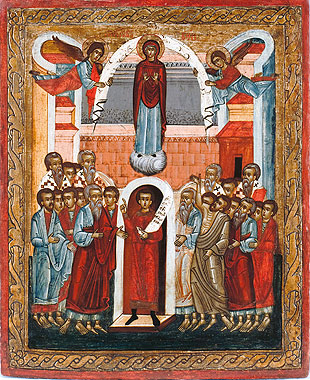 The
following icons date back to the second half of the 16th century. It
should be noted that a standalone feast series appeared in the Ukrainian
iconostasis at the time, including 12 themes of the main feasts of the
church calendar. However, the theme of the Intercession of the Virgin
Mary was not among them. Yet, optional themes would sometimes appear in
feast series, including this one. An icon of the 1560s is an early
example of the Intercession theme. It was painted by master Dmitriy, one
of the iconographers whose name was recorded on early Ukrainian icons.
The icon comes from the Church in the village Dubrovitsa, Yavorivsky
district, Lviv region (NML). It is designed in two tiers against a
double grey and pink wall with two tower-like structures on the sides.
In the center of the upper tier, the Mother of God is standing on a
cloud, with Her open palms on Her chest. Two flying angels are holding a
white veil over the Virgin. In the lower center, against the arched
opening, Romanos the Melodist is standing on a pulpit, holding an
unfolded scroll in his left hand, pointing upwards with the index finger
of his right hand. On either side of the Melodist, there are two groups
of people standing in dense rows: in the foreground, there are men of
various ages in blue and orange chitons and himatia; on the left, Andrew
the Fool in an ocher himation draped over his naked body is pointing to
the Virgin with his right hand. In the second row, there are four
saints, and behind them, we can see some men’s heads. All figures of the
lower tier are depicted without halos.
The
following icons date back to the second half of the 16th century. It
should be noted that a standalone feast series appeared in the Ukrainian
iconostasis at the time, including 12 themes of the main feasts of the
church calendar. However, the theme of the Intercession of the Virgin
Mary was not among them. Yet, optional themes would sometimes appear in
feast series, including this one. An icon of the 1560s is an early
example of the Intercession theme. It was painted by master Dmitriy, one
of the iconographers whose name was recorded on early Ukrainian icons.
The icon comes from the Church in the village Dubrovitsa, Yavorivsky
district, Lviv region (NML). It is designed in two tiers against a
double grey and pink wall with two tower-like structures on the sides.
In the center of the upper tier, the Mother of God is standing on a
cloud, with Her open palms on Her chest. Two flying angels are holding a
white veil over the Virgin. In the lower center, against the arched
opening, Romanos the Melodist is standing on a pulpit, holding an
unfolded scroll in his left hand, pointing upwards with the index finger
of his right hand. On either side of the Melodist, there are two groups
of people standing in dense rows: in the foreground, there are men of
various ages in blue and orange chitons and himatia; on the left, Andrew
the Fool in an ocher himation draped over his naked body is pointing to
the Virgin with his right hand. In the second row, there are four
saints, and behind them, we can see some men’s heads. All figures of the
lower tier are depicted without halos.
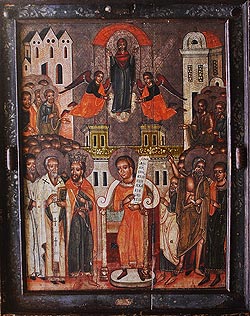 Another
version of the iconography is presented by the icon from the
Intercession Church in Medvezha (NML). The author of the Medvezha icon
depicted the Mother of God Oranta standing under a ciborium on a cloud,
supported by angels on the sides. Here, the ciborium acts as the
Omophorion. The half-sized figures of the apostles and John the
Forerunner are depicted to the left and right of the Mother of God. In
the lower center, Romanos the Melodist is traditionally depicted on the
pulpit; on the left are the emperor and clergymen; on the right is
Andrew the Fool, seemingly floating above the ground in admiration for
the vision, which he shows to his disciple Epiphanius.
Another
version of the iconography is presented by the icon from the
Intercession Church in Medvezha (NML). The author of the Medvezha icon
depicted the Mother of God Oranta standing under a ciborium on a cloud,
supported by angels on the sides. Here, the ciborium acts as the
Omophorion. The half-sized figures of the apostles and John the
Forerunner are depicted to the left and right of the Mother of God. In
the lower center, Romanos the Melodist is traditionally depicted on the
pulpit; on the left are the emperor and clergymen; on the right is
Andrew the Fool, seemingly floating above the ground in admiration for
the vision, which he shows to his disciple Epiphanius.
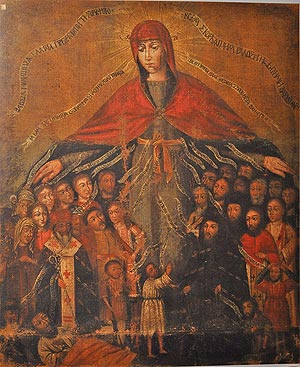 The
early version of the Intercession, “Mother of Mercy”, which appeared in
Ukrainian painting in the 17th century, is represented by the icon
dating back to the beginning of the century from the Church in Stara
Sil, Staryi Sambir (NML). The Mother of God uses Her robe to “cover” a
large crowd of people whose faces have a distinctly individualized
character. Their eyes are full of live emotion. The anonymous master
managed to capture the mood of each character. They also meticulously
recreated clothes, hairstyles and other attributes marking the social
status of their contemporaries. White ribbons with various inscribed
requests are winding up from the figures towards the Mother of God.
Images of this type were also common in Ukrainian gonfalons.
The
early version of the Intercession, “Mother of Mercy”, which appeared in
Ukrainian painting in the 17th century, is represented by the icon
dating back to the beginning of the century from the Church in Stara
Sil, Staryi Sambir (NML). The Mother of God uses Her robe to “cover” a
large crowd of people whose faces have a distinctly individualized
character. Their eyes are full of live emotion. The anonymous master
managed to capture the mood of each character. They also meticulously
recreated clothes, hairstyles and other attributes marking the social
status of their contemporaries. White ribbons with various inscribed
requests are winding up from the figures towards the Mother of God.
Images of this type were also common in Ukrainian gonfalons.
The Intercession of the Virgin Mary theme is particularly important in the heritage of Ukrainian sacred art and spiritual culture in general. It is reflected in rites, customs, and oral folklore. The Intercession, particularly in icon-painting, is one of the themes that, due to their peculiar national characteristics, are among the most interesting phenomena in its history and thus deserve special attention.

Δεν υπάρχουν σχόλια:
Δημοσίευση σχολίου
Σημείωση: Μόνο ένα μέλος αυτού του ιστολογίου μπορεί να αναρτήσει σχόλιο.